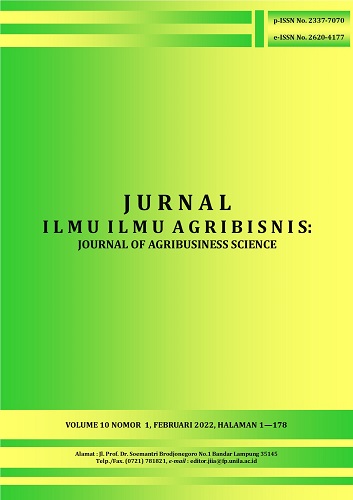ALIH FUNGSI LAHAN SAWAH DI KABUPATEN LAMPUNG SELATAN
DOI:
https://doi.org/10.23960/jiia.v10i1.5677 Abstract View: 666
Abstract View: 666
Abstract
Rice field conversion occurs due to the increasing land need. Rice fields were mostly converted to fulfill the needs of industry, regional development, and as residential land. The aims of this research were to know the rate of rice field conversion, factors that influence the rice field conversion, and the impact of the rice field conversion to the socioeconomic conditions of the community in South Lampung District. This research used a survey method and was conducted in three locations, namely: Natar, Jati Agung, and Tanjung Bintang Sub-districts. The first objective was analyzed by calculating the rate of partial land depreciation. The second objective was analyzed with logistic regression analysis.. The third objective was analyzed with qualitative and quantitative descriptive analysis. The results showed that the average rate of rice field conversion in South Lampung District is -0.02 percent per year. Factors that influence the rice field conversion were age, farming experience, and number of dependents. The impact caused by the rice field conversion were social mobility and decreased farmers' income by IDR 1,057,088.90 per month.
Key words: conversion, land, rice fields
Downloads
Downloads
Published
How to Cite
Issue
Section
License
Authors who publish with this journal agree to the following terms:
Authors retain copyright and grant the journal right of first publication with the work simultaneously licensed under a Creative Commons Attribution License that allows others to share the work with an acknowledgement of the work's authorship and initial publication in this journal.
Authors are able to enter into separate, additional contractual arrangements for the non-exclusive distribution of the journal's published version of the work (e.g., post it to an institutional repository or publish it in a book), with an acknowledgement of its initial publication in this journal.
Authors are permitted and encouraged to post their work online (e.g., in institutional repositories or on their website) prior to and during the submission process, as it can lead to productive exchanges, as well as earlier and greater citation of published work (See The Effect of Open Access).














